Lava Xolo X900 Review - The First Intel Medfield Phone
by Brian Klug on April 25, 2012 6:00 AM ESTBattery Life
Nailing performance is one thing, but in order to really sell Medfield and other upcoming SoCs to OEMs, Intel has to deliver battery life and power consumption that's competitive. It's about performance/power in the SoC space. First, it's worthwhile to note that the X900 includes a relatively small battery, at just 5.4 Whr. Of late, batteries over 6 Whr seems like the norm, and I'm told that future designs including the Motorola phone will probably include larger ones. It's just good to have that frame of reference and this chart should help:
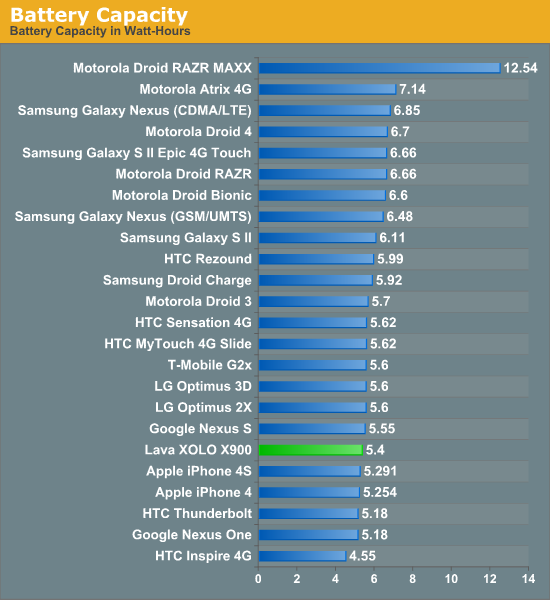
Intel notes battery life in their own X900 announcement blast as being around 5 hours of continuous 3G browsing and 8 hours of talk time. Our own numbers end up being pretty darn close, at 4.6 hours and 8.5 hours for those two metrics, respectively.
As a reminder, the browsing tests happen at 200 nits and consist of a few dozen pages loaded endlessly over WCDMA or WiFi (depending on the test) until the phone powers off. The WiFi hotspot tethering test consists of a single attached client streaming 128 kbps MP3 audio and loading four tabs of the page loading test through the handset over WCDMA with the display off.
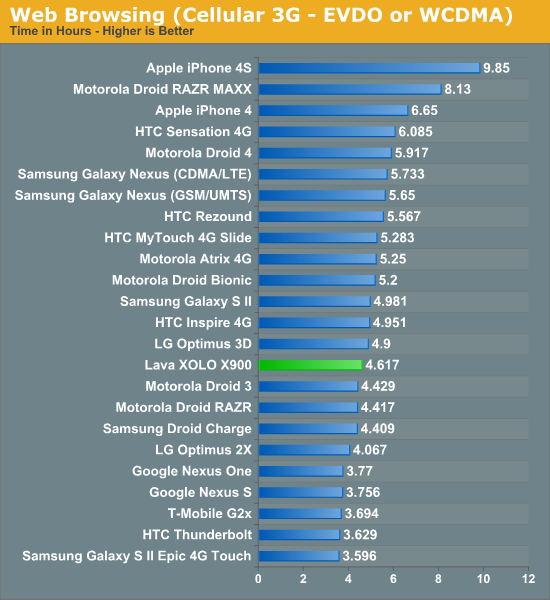
As a smartphone the X900 does a bit below average here, but as we mentioned it also has an unusually small battery for a modern flagship Android smartphone. If we divide battery life by battery capacity, we can get a better idea for how the Medfield platform compares to the competition:
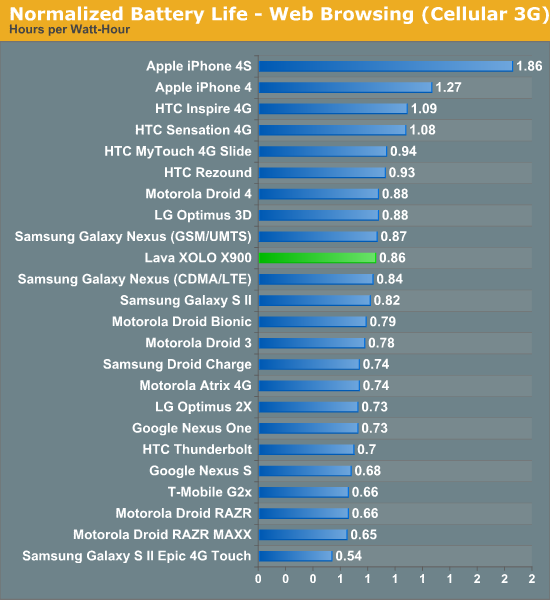
Normalizing for battery capacity, the X900 actually does a bit above average. In other words, the Medfield platform appears to be just as power efficient as some of the newer OMAP 4 based smartphones.
On WiFi the situation is no different:
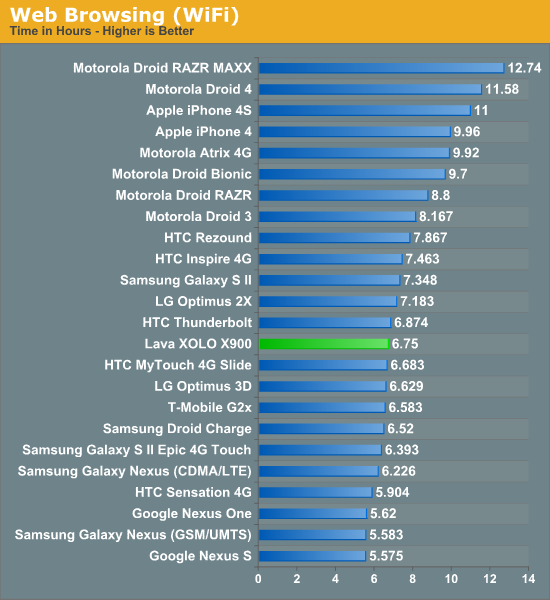
Again we see reasonable numbers for the X900 but nothing stellar. The good news is that the whole x86 can't be power efficient argument appears to be completely debunked with the release of a single device. To move up in the charts however, Intel needs to outfit its reference design with a bigger battery - something I've heard is coming with the Z2580's FFRD. The normalized results put the X900 at the middle of the pack:
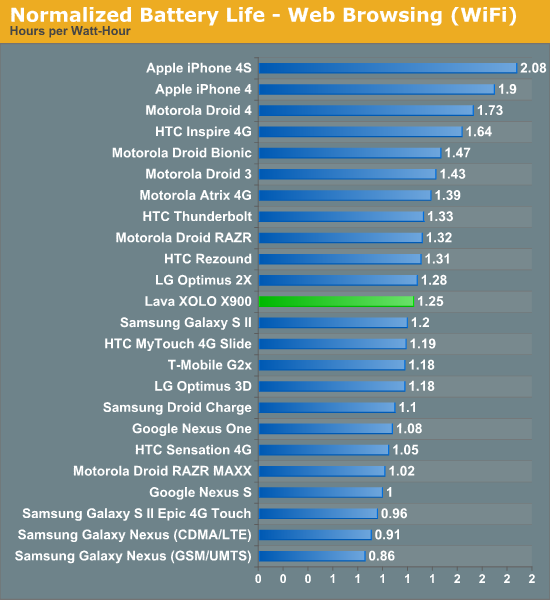
We see similar results in our talk time and 3G hotspot tests:

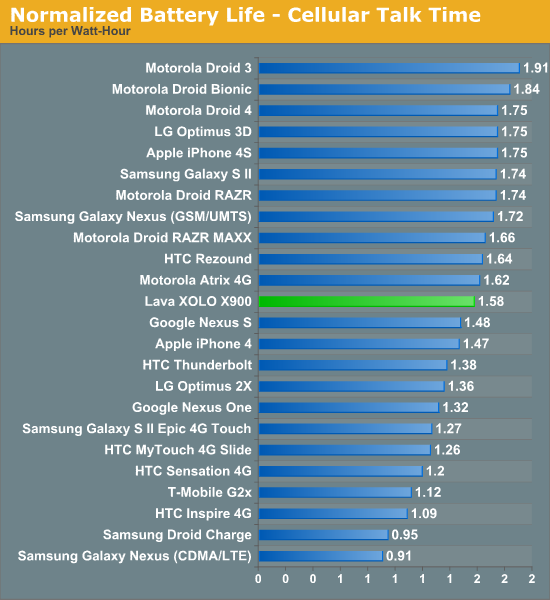
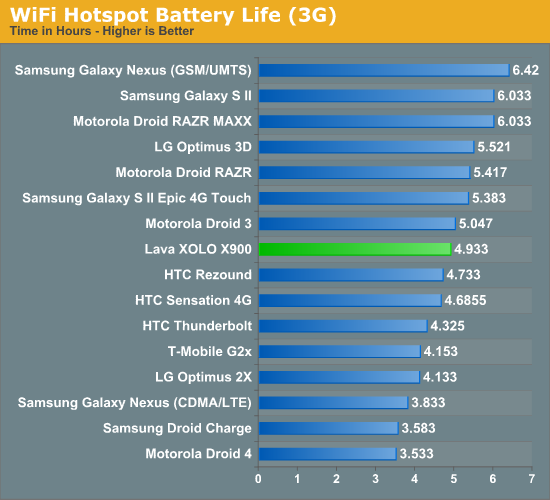
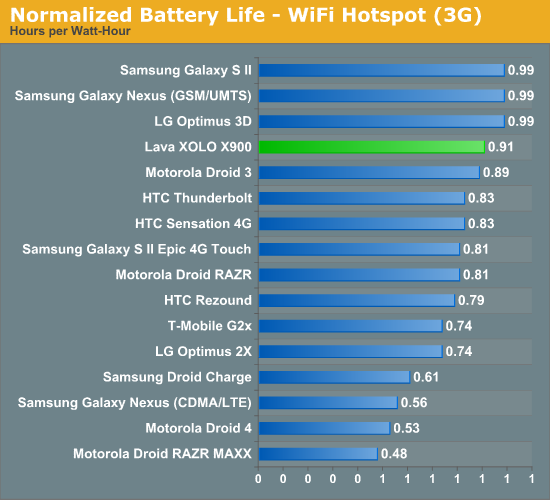










106 Comments
View All Comments
jwcalla - Wednesday, April 25, 2012 - link
Well... it's competitive. Ultimately it'll come down to who has the most desirable device. We know Apple has it's iPhone... Samsung the Galaxy S... Motorola the Droid Razr, etc. Intel would need to get in with one of those companies and be a top device to be accepted. Nobody is going to buy it just because it's Intel. (Except the fanboys of course.)dt1561 - Wednesday, April 25, 2012 - link
Looks cool but nothing extraordinary.fic2 - Wednesday, April 25, 2012 - link
Not that it matters much but does the display use Gorilla Glass?snoozemode - Wednesday, April 25, 2012 - link
Sure it's fun that Intel finally has proven that x86/Atom works in a smartphone, but the overall result is just a very bland phone that's not superior at anything really. And with a price of $420.. Why would anyone buy this?A5 - Wednesday, April 25, 2012 - link
That's $420 with no contract. Considering the average carrier subsidy is $300-$400, this is a firmly mid-range device.fm123 - Thursday, April 26, 2012 - link
That is the price in India, which could be a completely different situation than other countries.sonicmerlin - Wednesday, April 25, 2012 - link
So given the nature of x86, can we self-install other compatible operating systems such as an x86 port of MeeGo? I'm *very* interested in using MeeGo outside of the N9. What about the x86 ICS image that Google makes available on its own website? Are there any customization or tweaking requirements, or can we install any new OS the same way we would install Linux or Windows on typical x86 hardware?That would be the ultimate advantage of an x86 phone or tablet, no?
Finally, the battery tests here don't discuss standby battery life. That's always been an issue with Android, and is why every other OS seems to have much longer battery life than Android. We don't use our smartphones the way these battery torture tests suggest we do. Could you please download an app like Battery Monitor Widget and indicate how many mA are being used during standby?
dcollins - Wednesday, April 25, 2012 - link
Installing a new OS requires supported drivers. MeeGo could be installed in theory if you ported the necessary drivers from Android. They are both Linux based, so this is theoretically possible, but it will require a lot of hacking and technical expertise. The Windows driver model is totally different so you would have to reverse engineer drivers from scratch. That's not going to happen.This fight is not about x86 versus ARM as ISAs. It's about Intel versus ARM licensees: who can develop a faster, lower power chip? If Intel does their job well, the ISA shouldn't matter to the end user.
sonicmerlin - Thursday, April 26, 2012 - link
I think you misunderstand. MeeGo already provides support for x86. Technically it's now "Tizen", but regardless it's been developed with both ARM and x86 in mind. My main question is whether we can self-install an x86 port of MeeGo (or Tizen) onto this phone?fteoath64 - Saturday, April 28, 2012 - link
¨This fight is not about x86 versus ARM as ISAs. It's about Intel versus ARM licensees¨It blows down to just that!. The cost efficiency of ARM chips will just kill any chance of Intel getting into this market. Just look at a completely built Android handset made in china with retina display for $119. A retailer selling it for $160-199 will made heaps, if billions of units are involved. All licenses of chips and Android are legit. Not copycat stuff. Genuine Cortex A9 licenses.
It comes at a time when having 4-5 suppliers of ARM chips have made the market very resilient, something a single supplier can never do. So I say to Intel again, get an ARM license and play this game the right way. You can innovate very nicely with competition, and you really need that competition to keep your edge.